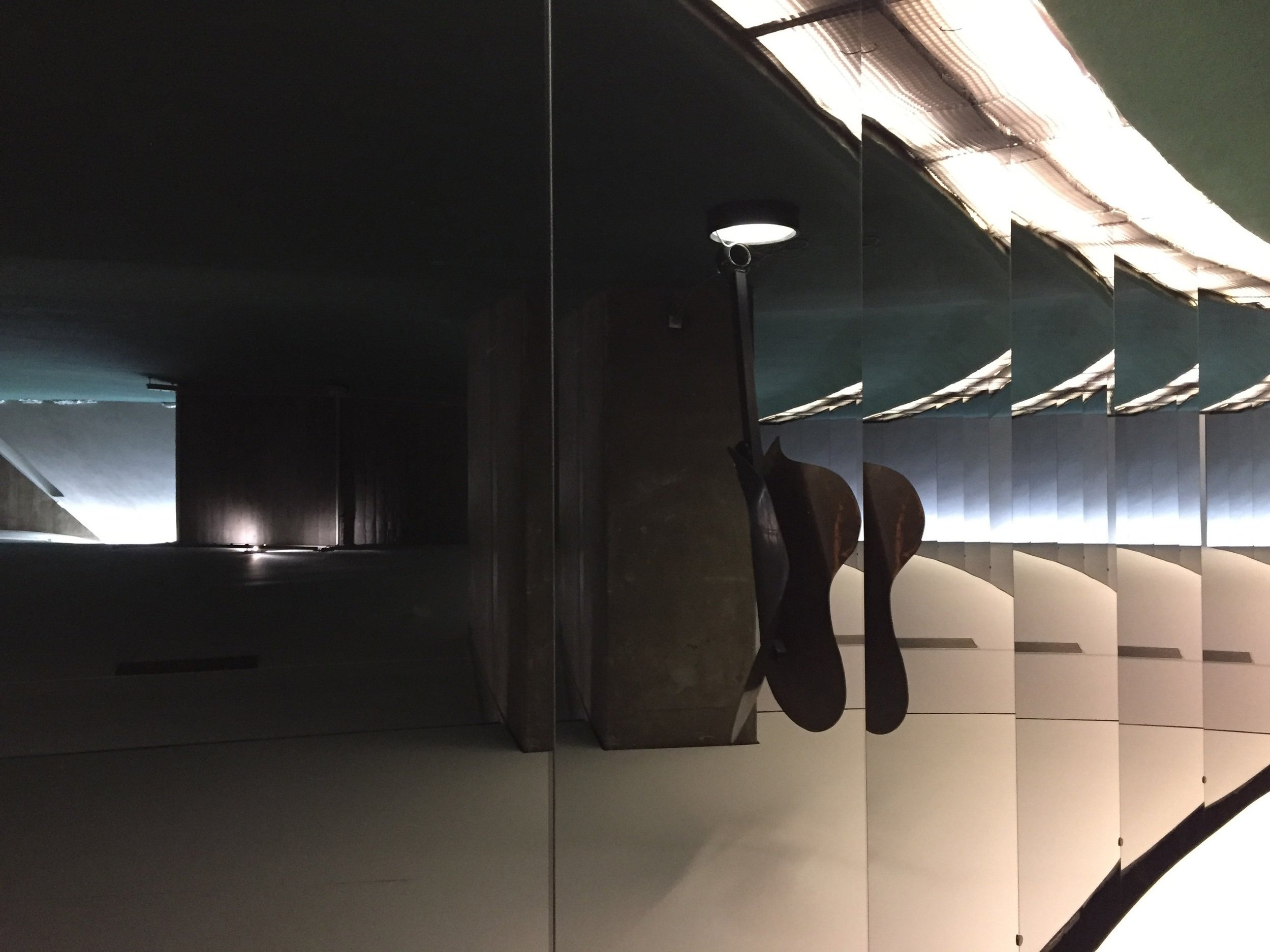
Psychostructure Profiling (LE SIEGE DU PARTI COMMUNISTE FRANCAIS / ESPACE NIEMEYER)
Function: Political party headquarters / location for hire
Architect: Oscar Niemeyer et al.
Construction: 1967-1980
Location: 19th Arrondissement, Paris
Psychological characteristics:
Defended subjects, fight/ flight
Migrant identity, development, fluidity, hybridity and isolation
Narcissistic culture, celebrity culture, cult of personality, charisma
Mourning and memorialisation
Play, creativity, therapy and social life
Methods used :
Family Tree for a Building
Architecture on the Couch
Deputised Objects
Visual Matrix
Days of Action
Buildings can ail and die if the life within them and the caring for them fails or is in contradiction with the building's subjectivity. We believe that deeper and sympathetic understanding can help us as their human creators, users and guardians to ensure their health, survival, continued relevance and contribution to social and cultural life. Our approach has included psychoanalytically informed methods investigating historical, social and cultural dimensions, alongside playfully creative and artistic approaches. When we acknowledge the importance of a transdisciplinary psychosocial approach, taking seriously both conscious and unconscious aspects of a building’s identity, it is possible to unearth and track unnoticed threads of continuity and contradictions across time. Le Siège/ Espace Niemeyer is a complex assemblage. Our holistic case study has shown it to have particular psychological traits, with traces of problematic adaptations to traumatic or significant influences that may no longer serve well in the present or future.
Defended subjects, fight/ flight
A history of attacks, resistance and needing to go underground produce a defended subjectivity hard to shake off. Located in the 19th Arrondissement, Le Siège faces a square formerly known as Place du Combat and renamed Place Colonel Fabien in 1945 in honour of a French communist resistance hero. A siege mentality is unconsciously inscribed in the history of the location of Le Siège, the PCF and the buildings subterranean forms. The practice of going underground is well rehearsed by the PCF during WWII and is re-enacted by Le Siège, to avoid Fascist attacks similar to those carried out on previous PCF headquarters. Going underground and digging in simultaneously reflects a state of fight and flight. Many of the buildings significant spaces are out of sight, buried underground. While Modernist flight is expressed in the bureau which soars above the site, barely tethered to the ground and its underground spaces. A defended quality to the space is created overall by the extensive use of poured concrete, a sunken entrance way, subterranean spaces and a perimeter fence encircling the building, preventing public use of the buildings open space/ esplanade. Can the building be helped to readjust to a less threatening present and reimagine itself as a less defended subject? Can the perimeter fence between the public facing esplanade and the street finally be taken down? Would reinstatement of the esplanade as a civic space and open access to the Hall of the Workers reconcile the building in its original function, as a house of the people, with its new identity as Espace Niemeyer?
Migrant identity, development, fluidity, hybridity and isolation.
The need to fit in, change and develop in a new adopted place of refuge requires a certain fluidity. Migrant identity always partakes of the multiple and the hybrid. It makes the paradox of being one and many particularly visible and poignant. The building itself is infused with this hybrid identity blending the rational, clean, straight lines of Modernist architecture with the curvilinear, sinuous forms reminiscent of the Hills of Rio, queering Modernist architecture. The identity of the building is definitely a ‘they’, the beautiful, seductive offspring of a migrant, multiculturally conceived, embodying masculine and feminine qualities in form. This also brings about a uniqueness that may bring with it a sense of isolation, but also projections that may range from admiration on the more positive side to envy and seductiveness. If people think of you as exotic and seductive, a wish to possess may follow. The temptation to exploit the vulnerability of the beautiful migrant is an issue. The building’s status as a national monument reflects a desire by the state for further cultural assimilation in-spite of divided public opinion amongst Parisians. As a migrant can the building provide a home to those helping fellow migrants, the lonely and marginalised in society?
Narcissistic culture, celebrity culture, cult of personality, charisma
Charismatic authority has been a feature of the PCF and the building from its inception. Charismatic political and artistic figures within the party have fostered a cult of personality which continues to haunt the building to the present day. The flagship headquarters envisioned by the longest standing and larger than life leader Maurice Thorez was intended to be both an image and a tool of a desired future. However, creative freedom could only be fully realised after his death, with the rejection of Stalinism and social realism. A political charismatic leader is replaced by an artistic one, namely the political refugee and star architect Oscar Niemeyer who dwarfs in glamour the many others involved in the design and construction of the headquarters. The complex assemblage that is Le Siège is a child of its time enacting a culture of charismatic leadership. Flair, exuberance and a sense of the spectacular is re-cast into mute architectural form, attracting high end fashion shoots and filming activities. Consumerist and celebrity culture bring in through the front door a culture of narcissism, at odds with communist ideology, staging an architectural antagonism between the buildings intended and current use. Diminished financial and political standing of the PCF mean the building has to earn its keep and support its PCF parent by renaming itself Espace Niemeyer in 2002. A cult of personality continues to surround the building after its reincarnation as a cultural venue for hire. Capitalism in its most narcissistic superficiality could be said to have won over communism.
How can the complex beauty of the building be celebrated in its own right and through activities that are creative and not just about beauty creation through make up and costly apparel? Its beauty and significance in the Parisian built environment are partly celebrated through its designation as national monument, but the activities therein still speak mostly to the narcissistic aspect of contemporary culture. The importance of art in its own right is eclipsed but was an important impulse in the formation of the party and this building.
Mourning and memorialisation
Memorials are about remembering and honouring the dead and the past. We need memorials to remember over long periods of time. Memory however is held by the living. If we are haunted by memory it is hard to be fully alive.
To what extent has the building been able to mourn the loss of its parents, namely the PCF and Oscar Niemeyer? Freud told us that if we can’t mourn a loss, we may descend into melancholia. The PCF is a shadow of its former self, barely surviving, fed by capitalists who desire Le Siège in its reincarnation as Espace Niemeyer. Denial and disavowal are a defence against loss. While they may serve the PCF for a limited time, they have to be overcome and the loss acknowledged and accepted. The PCF’s disavowal of its marginality, its loss of power and influence and the painfulness of being sustained by its old enemy, capitalism, is a haunting that needs to be worked with and overcome, before a new avenue for living may be found for both the party and building.
Niemeyer is alive in memory and memorialised in the building’s name change to Espace Niemeyer. Does the ghost of Niemeyer as celebrity haunt the party and building, and attract the wrong kind of 'membership'? What of the past can offer a more creative and lively future? Could it help to remember Niemeyer less as a celebrity personality and more as a refugee who was given asylum and an important commission? Could a renewed engagement with artists heal the trauma of existential crisis the party faces by rediscovering for it a new sense of identity and belonging in society? Rather than repeating the trauma of hosting capitalism, the PCF could become a headquarters of culture and politics…a culture-polis. Art could play an essential role in changing the fortunes of the party by; fostering creative innovation within the party and its organisation, and in its use of the building; offering the party new perspectives on life and society and sharing its values with people from different backgrounds. As well as conveying a message of survival, creativity and renewal, art could generate a much-needed income for the party, an earning capacity that is aligned with its political ideology.
Play, creativity, therapy and social life.
This building performs more than most. It offers multi-various forms of inhabitation that could be construed as playful; in its curvilinear and oblique floor and wall planes and carpet that runs up the walls, in reflections that multiply, in a retro- futuristic quality that plays with time and, while against PCF principles, maybe even in its commercial use by film and fashion. Playfulness is transgressive after all. Within the party there is a history of debate around artistic freedom of expression long associated with strict Soviet Stalinist principles. The much debated and suppressed principle of creative freedom was established in 1966 in the final resolution of the Central Committee of Argenteuil. This allowed Le Siège to come into being. What if the haunting of that past has stymied and perverted the inherent and playful qualities of the building?
What if a culture and practice of play could be initiated through structured, and improvised events? Creative engagement and playfulness fosters relatedness, connectedness and spontaneous interaction. Play intervenes and disrupts normalised codes of behaviour and inhabitation that can close down the potential of built space. What subjectivities would emerge the other side of habit? A playful dynamic also revitalises intellectual performance by offering new perspectives and novel solutions.
What if therapy for the building is linked to recovering its playful capacity? Could therapy point to and heal the architectural antagonisms that are currently haunting the building? There is a link between therapy, play and cultural experience. The capacity to play underpins the capacity to heal and be healed as well as creative cultural participation. These approaches we think may be applicable to a building’s complex life and a healthy longevity too.




